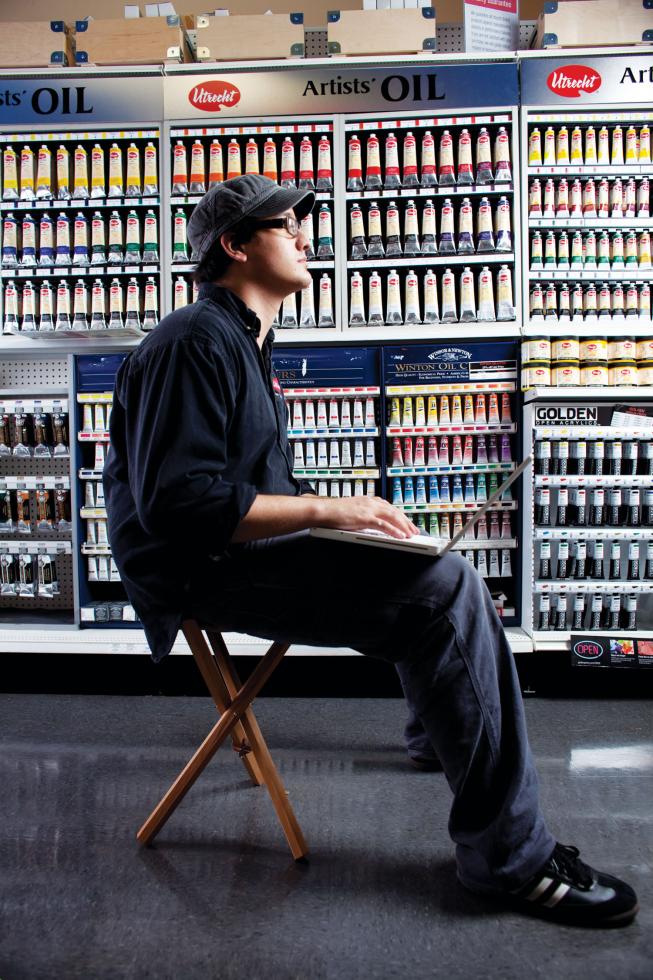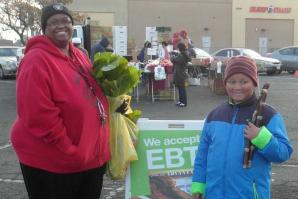Andrew Cook, assistant manager, Utrecht Art Supplies

As shopkeepers have done for thousands of years, Andrew Cook talks with his customers about what he ought to carry at the Utrecht Art Supplies store on Howe Avenue. The difference is that Cook, Utrecht’s assistant manager, holds the conversations on Facebook. The store had nearly 800 fans as of late November.
“We get a lot of questions we can answer that way,” Cook says. “People generally like having that interaction outside the store. It definitely pushes business when people can find out what is going on without having to call or come in, and that leads them to call and come in.”
Technology is changing retail, and trends are going far beyond bar code scanners and plastic loyalty cards. Already stores and restaurants are using Twitter to announce sales exclusively for registered followers. As technology makes it easier to track a person’s buying habits, expect to see more discounts tailored to individual shoppers and various modes of connection. Sign up for a special program, and as you walk into a store you might get a text message on your cell phone telling you about a product in a certain aisle. In the years to come, a fingerprint reader could replace the use of plastic loyalty cards.
All of this, of course, involves collecting data on shoppers.
In a sense, what’s happening now is only an extension of what retailers have always done. They took inventory with a clipboard to see which products sold the quickest. They knew their loyal customers because they talked to them in person. Even the technology has been around long enough to be familiar: the bar code since 1974 and loyalty cards as commonplace since the ’90s.
But today’s tools are cheaper and easier to use, says Sterling Hawkins, vice president of Hawkins Strategic LLC in Los Angeles. At the same time, the weak economy has motivated retailers to squeeze more from the tools they already have.
The trend begins with mass marketing — offering the same deal to everyone. Then a store focuses on special deals for the best 30 percent of customers, perhaps those spending more than $500 a month, Hawkins says. Then other deals can be offered to lower tiers such as $300-a-month spenders, and so on. Ultimately it could all be automated, so no human has to sit around deciding which shoppers get which deals.
Some stores deliver personalized weekly ad fliers to enrolled customers. Printing is a nonissue — ads are sent by e-mail, a Web page or an in-store kiosk.
“Across every customer segment, these shoppers spend more, shop more frequently and have higher annual retention rates than nonparticipants, all while reducing overall markdown expense,” according to a Hawkins Strategic paper on the subject.
In midtown Sacramento and the Arden area, Downtown Grid is combining its registered customer base with Twitter. Downtown Grid promotes independent local businesses through separate websites for the neighborhoods. Last month the company announced plans to launch a nationwide expansion.
“The first part of our strategy with Twitter is encouraging our local registered website users to follow us on Twitter and to enable our Tweets to come straight to their phones,” says Adam Smithline, president and CEO.
Rather than following the usual Twitter route of amassing as many followers as possible, Downtown Grid focuses on the community aspect. Independent businesses make special offers for Twitter followers with the intention of catching them while they are out and about. In many cases the deals are time-sensitive, perhaps lasting only one day, so the follower has incentive to act quickly.
“There’s got to be full disclosure. Before there is any transfer of information or data, each party knows exactly what the deal is going to be.” Sterling Hawkins, vice president, Hawkins Strategic LLC
Downtown Grid doesn’t demand much information from people who register, but does provide ways for them to volunteer it, Smithline says. As the company revamps its site and grows, it plans to get sophisticated with the offers, tailoring them by age, gender or areas of interest.
Big retailers are also finding value in customer data itself. Stripped of details that would identify particular shoppers, the data can be packaged and marketed like a product.
The Ohio-based Kroger Co. grocery chain is selling such data to what the industry calls “fast-moving consumer goods manufacturers,” according to Hawkins Strategic. “FMCG manufacturers like Procter & Gamble, [Kraft Foods Inc.] and many others have anted up millions of dollars for access to Kroger’s data and marketing initiatives. Kroger, in short, has created a new source of profit: monetizing shopper data,” the report says. As of last year, North Carolina’s Food Lion chain was regularly sharing retail data with more than two-dozen key suppliers and working to increase this number to at least 100, according to Hawkins Strategic.
Customer information is a hot-button issue, Hawkins says, and stores shouldn’t be sneaky about how they obtain it or use it.
“There’s got to be full disclosure. Before there is any transfer of information or data, each party knows exactly what the deal is going to be,” he says. Customers also need to know what they are getting in exchange for their shared information and be able to opt out.
“I don’t think there is going to be one model of that,” he says. “I think we are going to see different retailers do it in different ways.”
Part of a national chain, the Howe Avenue Utrecht store has little control over products and pricing. But the interaction with customers on Facebook can help predict demand more accurately. The Facebook fan base includes a fair amount of college art students.
“It helps us know what the students are going to be needing for each semester, and we can prepare,” Cook says. “The more people we have who want something, the better price we can get on it.”
Not all of the store’s fans are in Sacramento. Some aren’t even in the United States. Overseas fans can’t walk into the store, of course, but, “It’s a good tool for us to feel around and see what people are interested in,” Cook says.
The store hasn’t tried to collect names or addresses from the Facebook fan base.
Likewise, Heller Pacific Inc. uses Facebook to spread the word about its Midtown Arts, Retail, & Restaurant Scene building, rather than gather data about friends and fans.
The only tie-in so far has been a promotion that offered a prize for sending more fans to the MARRS â?¨Facebook page, says property manager Liz Harris. The initial goal was to hit the 100 mark, with a Pete’s Coffee gift card to the person who persuaded the 100th fan to register.
“We’re still in the testing phase, where we are trying to figure out for ourselves what works best and what kind of information we want to put out there,” Harris says.
With these tactics, Hawkins says it’s smart to take a careful approach.
“If a retailer oversteps their bounds, especially in the era of social media we are in, there will be a backlash against them,” he says. Step too far over the line, and it might put a small retailer out of business. But a store doesn’t have to pry to squeeze more utility out of customer buying habits.
Revionics Inc. in Roseville uses software to analyze buying habits and predict how a planned promotion will affect the rest of the store, such as whether a clearance price announced in a Sunday supplement will cannibalize sales of similar products in the store.
“The large majority of retail establishments are not utilizing what we call consumer-demand intelligence,” says Susan Boyme, Revionics’ vice president of marketing.
The idea is to take the guesswork out of customer sensitivity under various circumstances. Revionics will start with up to two years of records showing sales at a particular store, and at what price. Then it looks at current costs and competitive prices. Added to that mix are the store’s margin targets, sales targets and other goals. The whole package is delivered over the Internet, so it doesn’t require special hardware or software installation.
“We can tell whether or not they are a loyalty club member, and we can tie that to buying behavior.” Susan Boyme, vice president of marketing, Revionics Inc.
“We’re able to collect what is called market basket information: What are people buying at the same time? We can tell whether or not they are a loyalty club member, and we can tie that to buying behavior,” she says.
Combine that with geographic information, and a chain can tell whether a particular product is selling better on one side of town than another. Or, if a small store sees Wal-Mart as a threat, the software can pick 200 items on which the small store should match Wal-Mart’s price, rather than trying to compete on 20,000 items.
The future for Revionics is to extend optimization to other aspects of retailing: the assortment of items on the shelves, how much space to allocate to each and how often to replenish it.
Stores also have learned to cash in on a shopper’s affinity for organizations that have nothing to do with the store. By using a special plastic card that looks like a credit card, the shopper can allocate a rebate to a particular school, church or other group registered with the store.
Nietech Corp. in Santa Rosa has built an entire business around that concept. It administers the back end of the transaction, seeing that the right amount of money gets to the right groups.
The Raley’s chain has offered such a program with its Quality of Life cards, but they are good only at Raley’s, Bel Air and Nob Hill Foods stores. Nietech is working on something more ambitious. The idea is to gather a variety of retailers under the banner of Help Worldwide, says Don Dunbar, Nietech’s president and CEO. A shopper could allocate a rebate to any program registered with Help Worldwide from any store in the network.
That means a Sacramentan traveling to New York or internationally could seek out the Help Worldwide logo on a storefront, use the card when buying something, and automatically support a Sacramento program with the rebate. It’s just getting started, Dunbar says, but he’s already working on partnerships in Mexico and Germany.
For such a system to work, the cards have to act essentially like a credit card. In fact, the cards pass through the same reader to collect customer and beneficiary information, and the cards are verified through the MasterCard network, Dunbar says. The bank identification number on the card is programmed not to allow it to be used for actual purchases, only as an auxiliary card so that the rebate can be credited to the right program.
Using such a system addresses security issues. In this case, the information collected is the identification of the merchant and the cardholder, and the date and amount spent, but no breakdown by item purchased.
“What we provide for the merchants is a report — what ZIP codes their customers are coming from and what they are spending,” Dunbar says.
As technology improves and retailers get adept at using it, look for more customized pricing to smaller, segmented groups.
“If everybody is shopping at a supermarket and all paying the same prices, some people are only buying the discounted items. There are other customers that buy everything they need for the week whether they are on sale or not,” Hawkins says. That means one customer is, in effect, subsidizing the other, and the retailer is losing out on money one of the customers would have been willing to pay.
“The only way to curb that is to start personalizing and customizing the interaction,” he says.
Recommended For You

Built to Fill
Highway 50 corridor retailers continue to struggle with vacancy
The icy retail climate along the Highway 50 corridor east of Sacramento is slowly beginning to thaw, but an overabundance of standing inventory remains.

Healthy Options
Farmers markets and urban growers combat local food deserts
Despite living near some of the most productive farmland on earth, many Sacramentans are unable to find produce that’s both fresh and affordable in their own neighborhoods.


